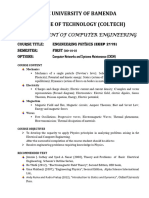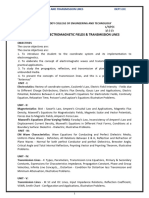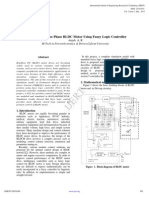Module 1 Introduction To Electromagnetics
Uploaded by
EJ GonzalesModule 1 Introduction To Electromagnetics
Uploaded by
EJ GonzalesRepublic of the Philippines
CAMARINES NORTE STATE COLLEGE
F. Pimentel Avenue, Brgy. 2, Daet, Camarines Norte
COLLEGE OF ENGINEERING
MODULE 1: INTRODUCTION TO ELECTROMAGNETICS AND VECTOR ANALYSIS
OUTLINE OF LEARNING TOPICS TIME ALLOTMENT: 3 HOURS
Introduction to Mechanics
1.1 Introduction
1.2 Vector Analysis
1.2.1 Scalar and Vectors
1.2.2 Vector Algebra
1.2.3 Dot Product and Cross Product
1.2.4 Vector Components and Unit Vectors
1.3 Coordinate System and Transformation
1.3.1 Cartesian Coordinate System
1.3.2 Circular Coordinates System
1.3.3 Spherical Coordinates System
INTENDED LEARNING OUTCOMES:
By the end of the module, you will:
• develop a solid understanding of the fundamental concepts of
electromagnetics in real world;
• define physical quantities such scalar and vector fields;
• recall the rules of vector arithmetic, vector algebra;
• represent a given point and vector in Cartesian, cylindrical and spherical
coordinates; and
• transform a vector in Cartesian to cylindrical and spherical coordinates;
1.1 INTRODUCTION
Electromagnetic force is one of the four fundamental forces of nature, alongside
gravitational, weak nuclear, and strong nuclear forces. It plays a crucial role in holding
atoms, matter, and the universe together by producing light and energy.
Engineering electromagnetics is a branch of electrical engineering that focuses on
studying electromagnetic fields, waves, and their interactions with materials and devices.
This subject is fundamental to many modern technologies, including wireless communication
systems, radar, microwave engineering, and power electronics.
The study of the interaction between electric and magnetic fields is known as
electromagnetism in physics. Electric charges in all matter can be positive, negative, or zero.
Like charges repel each other while opposite charges attract. Atoms are held together by
these electric forces, and an electric field arises when an atom gains a positive or negative
charge due to the transfer of an electron.
There are some fundamental concepts of electromagnetics in the real world such as:
1. Wireless communication: Electromagnetic waves are used to transmit
information wirelessly, such as in radio and television broadcasting, cellular
networks, and satellite communication systems.
2. Power generation and distribution: Electromagnetic induction is used to
generate electricity in power plants, while transformers use electromagnetic fields
to step up or step down voltage for efficient power distribution.
3. Medical imaging: Magnetic resonance imaging (MRI) uses strong magnetic
fields and radio waves to produce detailed images of internal body structures for
medical diagnosis.
Prepared by: MYRINE YSOBELLE S. SIOCO, REE, RME, LPT
AS 103 – ELECTROMAGNETICS
Page 1 of 12
Republic of the Philippines
CAMARINES NORTE STATE COLLEGE
F. Pimentel Avenue, Brgy. 2, Daet, Camarines Norte
COLLEGE OF ENGINEERING
4. Radar and remote sensing: Electromagnetic waves are used in radar systems
for detecting objects and measuring distances, while remote sensing techniques
use electromagnetic radiation to gather data about the Earth's surface and
atmosphere.
5. Electric motors and generators: Electromagnetic principles are used in the
design and operation of electric motors and generators, which are used in a wide
range of applications from industrial machinery to household appliances.
1.2 VECTOR ANALYSIS
Vector analysis is a mathematical tool used to describe and analyze physical
phenomena that involve vectors. It deals with the algebraic and geometric properties of
vectors and vector spaces. Vector analysis involves the use of vector operations such as
addition, subtraction, dot product, cross product, and differentiation to solve problems in
various fields such as physics, engineering, and mathematics. It is an essential tool for
understanding and analyzing electromagnetic fields and waves in engineering
electromagnetics.
1.2.1 SCALAR AND VECTORS
A scalar quantity is a physical quantity that has only magnitude and no direction.
Examples of scalar quantities include temperature, mass, volume, and time. Scalar
quantities can be added, subtracted, multiplied, and divided using ordinary arithmetic
operations.
On the other hand, a vector quantity is a physical quantity that has both magnitude
and direction. Examples of vector quantities include displacement, velocity, acceleration,
force, and electric field intensity. Vector quantities are represented by arrows or boldface
letters and can be added or subtracted using vector addition or subtraction rules.
In engineering electromagnetics, vector analysis is used extensively to describe the
behavior of electromagnetic fields and waves. The electric field intensity (E) and magnetic
field intensity (H) are examples of vector quantities that are used to describe the properties
of electromagnetic waves.
However in engineering electromagnetics we shall be mostly concerned with scalar
and vector fields. A scalar field is a physical field that assigns a scalar value to every point
in space. Examples of scalar fields include temperature distribution in a room or pressure
distribution in a fluid flow. Scalar fields can be visualized using contour plots or color maps.
On the other hand, a vector field is a physical field that assigns a vector value to
every point in space. Examples of vector fields include electric field intensity around an
electric charge or magnetic field intensity around a current-carrying wire. Vector fields can be
visualized using arrows or streamlines.
In engineering electromagnetics, both scalar and vector quantities as well as scalar
and vector fields are used extensively to describe the behavior of electromagnetic fields and
waves. Understanding the difference between these two types of physical quantities and
fields is essential in solving problems in engineering electromagnetics.
Prepared by: MYRINE YSOBELLE S. SIOCO, REE, RME, LPT
AS 103 – ELECTROMAGNETICS
Page 2 of 12
Republic of the Philippines
CAMARINES NORTE STATE COLLEGE
F. Pimentel Avenue, Brgy. 2, Daet, Camarines Norte
COLLEGE OF ENGINEERING
LEARNING ACTIVITY NO. 1: SCALAR AND VECTOR QUANTITIES
Identify the following statement if it is s a scalar or vector quantities.
1. If a time is multiplied by a velocity, is the resultant quantity a vector quantity or a
scalar quantity?
Ans. _________________________________________________________
2. If an acceleration is multiplied by a time, is the resultant quantity a vector quantity or
a scalar quantity?
Ans. _________________________________________________________
3. If a force is divided by a time, is the resultant quantity a vector quantity or a scalar
quantity?
Ans. _________________________________________________________
4. If a speed is multiplied by a time, is the resultant quantity a vector quantity or a scalar
quantity?
Ans. _________________________________________________________
5. If an area is multiplied by a length, is the resultant quantity a vector quantity or a
scalar quantity?
Ans. _________________________________________________________
6. If a mass is multiplied by an acceleration, is the resultant a vector quantity or a scalar
quantity?
Ans. _________________________________________________________
7. If a mass is multiplied by a velocity, is the resultant a vector quantity or a scalar
quantity?
Ans. _________________________________________________________
8. A weather forecast states the temperature is predicted to be −15°C the following
day. Is this temperature a vector or a scalar quantity?
Ans. _________________________________________________________
9. The car accelerated North at a rate of 6 meters per second squared.
Ans. _________________________________________________________
10. The player was running 5 miles an hour towards the end zone, 5. 25 km
Ans. _________________________________________________________
Identify the following statement if it is s a scalar or vector field.
1. The temperature throughout the bowl of soup.
Ans. _________________________________________________________
2. The density at any point in the earth
Ans. _________________________________________________________
3. The gravitational and magnetic fields of the earth.
Ans. _________________________________________________________
4. The voltage gradient in a cable.
Ans. _________________________________________________________
1.2.2 VECTOR ALGEBRA
Vector algebra is a branch of mathematics that deals with the algebraic and
geometric properties of vectors. In engineering electromagnetics, vector algebra is used
extensively to describe and analyze electromagnetic fields and waves.
Prepared by: MYRINE YSOBELLE S. SIOCO, REE, RME, LPT
AS 103 – ELECTROMAGNETICS
Page 3 of 12
Republic of the Philippines
CAMARINES NORTE STATE COLLEGE
F. Pimentel Avenue, Brgy. 2, Daet, Camarines Norte
COLLEGE OF ENGINEERING
Vector algebra involves the use of vector operations such as addition, subtraction to
solve problems in various fields such as physics, engineering, and mathematics. Here are
some key concepts in vector algebra:
1. Vector addition: Two vectors can be added by placing them head-to-tail
and drawing a vector from the tail of the first vector to the head of the
second vector. The resulting vector is called the sum of the two vectors. It
obeys the commutative law and associative law.
2. Vector subtraction: Two vectors can be subtracted by adding the
negative of one vector to the other vector.
Law Addition Multiplication
Commutative A+B=B+A rA = Ar
Associative A + (B + C) = (A + B) +C r(sA) = (rs)A
Distributive r(A + B) = rA + rB
Where, r and s are scalars
In vector algebra, vectors can be multiplied by scalars, which results in a change
in the magnitude of the vector but not its direction when the scalar is positive. However,
when multiplied by a negative scalar, the direction of the vector is reversed. The
multiplication of a vector by a scalar also obeys the associative and distributive laws of
algebra. Division of a vector by a scalar is simply multiplication by the reciprocal of that
scalar. These operations are fundamental in engineering electromagnetics and are used to
describe and analyze electromagnetic fields and waves.
3. Vector multiplication: When two vectors A and B are multiplied, the
result is either a scalar or a vector depending on how they are multiplied.
Thus there are two types of vector multiplication:
a. Scalar (or dot) product: 𝐴 ∙ 𝐵
b. Vector (or cross) product): 𝑨 𝑥 𝑩
Note: Multiplication of three vectors A, B and C can result in
either
a. Scalar triple product: 𝐴 ∙ (𝑩 𝑥 𝑪)
b. Vector triple product: 𝑨 𝑥 (𝑩 𝑥 𝑪)
1.2.3 DOT AND CROSS PRODUCT
The dot product of two vectors is a scalar quantity that is equal to the product of
their magnitudes and the cosine of the angle between them.
A . B = |A| |B| cos θAB
Where θAB is the smaller angle between A and B
𝐴 ∙ 𝐵 = 𝐴! 𝐵! + 𝐴" 𝐵" + 𝐴# 𝐵#
The dot product obeys the following rules:
Commutative law: 𝐴 ∙ 𝐵 = 𝐵 ∙ 𝐴
Prepared by: MYRINE YSOBELLE S. SIOCO, REE, RME, LPT
AS 103 – ELECTROMAGNETICS
Page 4 of 12
Republic of the Philippines
CAMARINES NORTE STATE COLLEGE
F. Pimentel Avenue, Brgy. 2, Daet, Camarines Norte
COLLEGE OF ENGINEERING
Distributive law:
𝐴 ∙ (𝐵 + 𝐶) = (𝐴 ∙ 𝐵) + (𝐴 ∙ 𝐶)
𝐴 ∙ 𝐴 = |𝐴|$
Also note that,
𝑎! ∙ 𝑎" = 𝑎" ∙ 𝑎# = 𝑎# ∙ 𝑎! = 0
𝑎! ∙ 𝑎! = 𝑎" ∙ 𝑎" = 𝑎# ∙ 𝑎# = 1
The cross product of two vectors is a vector quantity that is perpendicular to both
vectors and has a magnitude equal to the product of their magnitudes times the sine of the
angle between them.
A x B = aN |A| |B| sinθAB
Where: aN is a unit vector normal to the plane containing A and B
If 𝐴 = 𝐴! , 𝐴" , 𝐴# and 𝐵 = 𝐵! , 𝐵" , 𝐵# then,
𝑨 𝑥 𝑩 = (𝑨" 𝑩# − 𝑨# 𝑩" )𝑎! + (𝑨# 𝑩! − 𝑨! 𝑩# )𝑎" + (𝑨! 𝑩" − 𝑨" 𝑩! )𝑎#
Or written as a determinant in a more easily remembered form,
The cross product has the following basic properties:
• It is anticommutative: 𝑨 𝑥 𝑩 = −(𝑩 𝑥 𝑨)
• It is not associative: 𝑨 𝑥 (𝑩 𝑥 𝑪) ≠ (𝑨 𝑥 𝑩) 𝑥 𝑪
• It is distributive: 𝑨 𝑥 (𝑩 + 𝑪) = (𝑨 𝑥 𝑩) 𝑥 (𝑨 𝑥 𝑪)
• 𝑨𝑥𝑨=0
Also, 𝑎! 𝑥 𝑎" = 𝑎# ; 𝑎" 𝑥 𝑎# = 𝑎! ; 𝑎# 𝑥 𝑎! = 𝑎"
LEARNING ACTIVITY NO. 2: DOT AND CROSS PRODUCTS
1. Given points A(2,5,-1),B(3,-2,4) and C(-2,3,1),find (a)RAB ∙ RAC; (b) the angle between
RAB and RAC; and (c) the length of the projection of RAB on RAC. (d) the vector
projection of RAB on RAC.
2. A triangle is defined by three points A(2, -5, 1), B(-3, 2, 4), and C(0, 3,1). Find (a) RBC
x RBA; (b) the area of the triangle; (c) a unit vector perpendicular to the plane in which
the triangle is located.
Prepared by: MYRINE YSOBELLE S. SIOCO, REE, RME, LPT
AS 103 – ELECTROMAGNETICS
Page 5 of 12
Republic of the Philippines
CAMARINES NORTE STATE COLLEGE
F. Pimentel Avenue, Brgy. 2, Daet, Camarines Norte
COLLEGE OF ENGINEERING
1.2.4 VECTOR COMPONENTS AND UNIT VECTORS
Vector components and unit vectors are two important concepts in vector algebra
that are used extensively in engineering electromagnetics.
Vector Components:
A vector can be represented as the sum of its components along two or three
mutually perpendicular axes. For example, a two-dimensional vector can be represented as
the sum of its x- and y-components, while a three-dimensional vector can be represented as
the sum of its x-, y-, and z-components. The process of finding the components of a vector is
called resolving the vector.
Distance Vectors:
Distance vector is the displacement from one point to another. If two points P and Q
are given by xP, yP, zP and xQ, yQ, zQ, the distance vector (or separation vector) is the
displacement from P to Q. That is,
𝑟%& = 𝑟& − 𝑟% = 6𝑥& − 𝑥% 7𝑎! + 6𝑦& − 𝑦% 7𝑎" + (𝑧& − 𝑧% )𝑎#
Unit Vectors:
A unit vector 𝑎' is defined as a vector whose magnitude is unity and its direction is
along A, that is,
𝑨
𝒂𝑨 =
|𝑨|
A vector A in cartesian (or rectangular) coordinates may be represented as,
𝐴! , 𝐴" , 𝐴# 𝑜𝑟 𝐴! 𝑎! + 𝐴" 𝑎" + 𝐴# 𝑎#
The magnitude of vector A is given by,
|𝑨| = <𝐴! $ + 𝐴" $ + 𝐴# $
and the unit vector along A is given by,
𝑨 𝐴! 𝑎! + 𝐴" 𝑎" + 𝐴# 𝑎#
𝒂𝑨 = =
|𝑨|
<𝐴! $ + 𝐴" $ + 𝐴# $
Example 1: The unit vector directed from the origin toward the point G(2, -2, -1) would be
obtained by first designating a vector G that extends from the origin to G(2, -2, -1)
𝑮 = 2𝒂𝒙 − 2𝒂𝒚 − 𝒂𝒛
Solution:
Find the magnitude G,
|𝑮| = ?(2)$ + (−2)$ + (−1)$ = 3
Prepared by: MYRINE YSOBELLE S. SIOCO, REE, RME, LPT
AS 103 – ELECTROMAGNETICS
Page 6 of 12
Republic of the Philippines
CAMARINES NORTE STATE COLLEGE
F. Pimentel Avenue, Brgy. 2, Daet, Camarines Norte
COLLEGE OF ENGINEERING
Express the desired unit vector as the quotient,
𝑮 2𝑎! − 2𝑎" − 𝑎# 2 2 1
𝒂𝑮 = = = 𝒂𝒙 − 𝒂𝒚 − 𝒂𝒛
|𝑮| 3 3 3 3
LEARNING ACTIVITY NO. 3: UNIT VECTOR
If A = 10ax - 4ay + 6az and B = 2ax + ay
Find: (a) the component of A along ay (ans. -4)
(b) the magnitude of 3A – B; and
(c) a unit vector along A + 2B.
1.3 COORDINATES SYSTEM AND TRANSFORMATION
In engineering, functions of both time and space are used to solve problems. To
characterize spatial changes of quantities, we must be able to define each point in space
uniquely and suitably. Curvilinear coordinate systems can represent a point or a vector,
either orthogonal or not. Orthogonal coordinate systems are preferred as they are
perpendicular to one another and easier to deal with. Nonorthogonal systems have little to
no application in real life. Choosing a coordinate system that best fits a specific task can
save time and effort. The three most well-known coordinate systems are Cartesian, circular
cylindrical, and spherical. Understanding these coordinate systems is fundamental to solving
problems in engineering electromagnetics.
1.3.1 CARTESIAN COORDINATE SYSTEM
The Cartesian coordinate system is a rectangular coordinate system that uses three
mutually perpendicular axes (x, y, and z) to specify the position of a point in three-
dimensional space. The x-axis is usually horizontal, the y-axis is vertical, and the z-axis is
perpendicular to the x-y plane. Any point in space can be uniquely defined by its x-, y-, and
z-coordinates.
1.3.2 CIRULAR CYLINDRICAL COORDINATE SYSTEM
The circular cylindrical coordinate system uses two perpendicular axes (ρ and z) and
an angle (∅) to specify the position of a point in three-dimensional space. The ρ-axis is
perpendicular to the z-axis and lies in the x-y plane, while ∅ is the angle between the x-axis
and the projection of the vector from the origin to the point onto the x-y plane. Any point in
space can be uniquely defined by its ρ-, ∅-, and z-coordinates.
Prepared by: MYRINE YSOBELLE S. SIOCO, REE, RME, LPT
AS 103 – ELECTROMAGNETICS
Page 7 of 12
Republic of the Philippines
CAMARINES NORTE STATE COLLEGE
F. Pimentel Avenue, Brgy. 2, Daet, Camarines Norte
COLLEGE OF ENGINEERING
The circular cylindrical coordinate system is very convenient to use when dealing
with problem having cylindrical symmetry.
The ranges of the variables are
0 ≤ 𝜌 < ∞; 0 ≤ 𝜙 < 2𝜋; −∞ < 𝑧 < ∞
The relationship between the variables (x, y, z) of the cartesian coordinate system:
𝑥 = 𝜌𝑐𝑜𝑠∅ 𝑦 = 𝜌𝑠𝑖𝑛∅ 𝑧=𝑧
𝑦
𝜌 = ?𝑥 $ + 𝑦 $ ∅ = 𝑡𝑎𝑛./ 𝑧=𝑧
𝑥
Dot products of unit vectors in Cylindrical and Cartesian coordinate system
By expanding these dot products, we have
𝑨𝝆 = (𝑨! 𝒂! + 𝑨" 𝒂" + 𝑨# 𝒂# ) ∙ 𝒂𝝆 = 𝑨! 𝒂! ∙ 𝒂𝝆 + 𝑨" 𝒂" ∙ 𝒂𝝆
𝑨∅ = (𝑨! 𝒂! + 𝑨" 𝒂" + 𝑨# 𝒂# ) ∙ 𝒂∅ = 𝑨! 𝒂! ∙ 𝒂∅ + 𝑨" 𝒂" ∙ 𝒂∅
𝑨𝒛 = (𝑨! 𝒂! + 𝑨" 𝒂" + 𝑨# 𝒂# ) ∙ 𝒂𝒛 = 𝑨# 𝒂# ∙ 𝒂𝒛 = 𝑨#
Note that,
aρ ∙ aρ = aØ ∙ aØ = az ∙ az = 1
aρ ∙ aØ = aØ ∙ az = az ∙ aρ = 0
aρ x aØ = az
aØ x az = aρ
az x aρ = aØ
A vector in cylindrical coordinates can be written as
𝑨𝝆 , 𝑨∅ , 𝑨𝒛 or 𝑨𝝆 𝒂𝝆 , 𝑨∅ 𝒂∅ , 𝑨𝒛 𝒂𝒛
The differential volume unit in the circular coordinate system: 𝒅𝝆, 𝝆𝒅∅, 𝑎𝑛𝑑 𝒅𝒛 and
the surfaces have areas: 𝝆𝒅𝝆𝒅∅, 𝒅𝝆𝒅𝒛 𝑎𝑛𝑑 𝝆𝒅∅𝒅𝒛
Prepared by: MYRINE YSOBELLE S. SIOCO, REE, RME, LPT
AS 103 – ELECTROMAGNETICS
Page 8 of 12
Republic of the Philippines
CAMARINES NORTE STATE COLLEGE
F. Pimentel Avenue, Brgy. 2, Daet, Camarines Norte
COLLEGE OF ENGINEERING
Example 2: Transform the vector B = yax + xay + zaz into cylindrical coordinates.
Solution: The new components are
𝛽2 = 𝑩 ∙ 𝒂𝝆 = 𝑦6𝒂𝒙 ∙ 𝒂𝝆 7 − 𝑥6𝒂𝒚 ∙ 𝒂𝝆 7
= 𝑦𝑐𝑜𝑠∅ − 𝑥𝑠𝑖𝑛∅ = 𝜌𝑠𝑖𝑛∅𝑐𝑜𝑠∅ − 𝜌𝑐𝑜𝑠∅𝑠𝑖𝑛∅ = 0
𝛽∅ = 𝑩 ∙ 𝒂∅ = 𝑦(𝒂𝒙 ∙ 𝒂∅ ) − 𝑥6𝒂𝒚 ∙ 𝒂∅ 7
= −𝑦𝑠𝑖𝑛∅ − 𝑥𝑐𝑜𝑠∅ = −𝜌𝑠𝑖𝑛$ ∅ − 𝜌𝑐𝑜𝑠 $ ∅ = −𝜌
Therefore,
𝑩 = −𝜌𝒂∅ + 𝑧𝒂#
1.3.3 SPHERICAL COORDINATE SYSTEM
The spherical coordinate system uses two angles (θ and ∅) and a distance (r) to
specify the position of a point in three-dimensional space. θ is the angle between the positive
z-axis and the vector from the origin to the point, while ∅ is the angle between the positive x-
axis and the projection of that vector onto the x-y plane. Any point in space can be uniquely
defined by its r-, θ-, and ∅-coordinates.
The spherical coordinate system is most appropriate when dealing with problems
having a degree of spherical symmetry.
A point P can be represented as (r, θ, ∅) as illustrated in the figure.
The ranges of the variables are
0 ≤ 𝑟 < ∞; 0 ≤ 𝜃 ≤ 𝜋; 0 ≤ 𝜙 < 2𝜋
The relationship between the variables (x, y, z) of the cartesian coordinate system:
𝑥 = 𝑟𝑠𝑖𝑛𝜃𝑐𝑜𝑠∅ 𝑦 = 𝑟𝑠𝑖𝑛𝜃𝑠𝑖𝑛∅ 𝑧 = 𝑟𝑐𝑜𝑠𝜃
𝑧 ?𝑥 $ + 𝑦 $ 𝑦
𝑟 = ?𝑥 $ + 𝑦 $ + 𝑧 $ 𝜃 = 𝑐𝑜𝑠 ./ 𝑜𝑟 𝑡𝑎𝑛./ ∅ = 𝑡𝑎𝑛./
?𝑥 $ + 𝑦 $ + 𝑧 $ 𝑧 𝑥
Prepared by: MYRINE YSOBELLE S. SIOCO, REE, RME, LPT
AS 103 – ELECTROMAGNETICS
Page 9 of 12
Republic of the Philippines
CAMARINES NORTE STATE COLLEGE
F. Pimentel Avenue, Brgy. 2, Daet, Camarines Norte
COLLEGE OF ENGINEERING
Dot products of unit vectors in Spherical and Cartesian coordinate system
By expanding these dot products, we have
𝑨𝒓 = 𝑨! 𝑠𝑖𝑛𝜃𝑐𝑜𝑠∅ + 𝑨" 𝑠𝑖𝑛𝜃𝑠𝑖𝑛∅ + 𝑨# 𝑐𝑜𝑠𝜃
𝑨𝜽 = 𝑨! 𝑐𝑜𝑠𝜃𝑐𝑜𝑠∅ + 𝑨" 𝑐𝑜𝑠𝜃𝑠𝑖𝑛∅ − 𝑨# 𝑠𝑖𝑛𝜃
𝑨∅ = −𝑨! 𝑠𝑖𝑛∅ + 𝑨" 𝑐𝑜𝑠∅
Note that, The unit vectors ar, aθ, and aØ are mutually orthogonal; and
ar . ar = aθ . aθ = aØ . aØ = 1
ar . aθ = aθ . az = aØ . ar= 0
ar x aθ = aØ
aθ x aØ = ar
aØ x ar = aθ
A vector in spherical coordinates can be written as
𝑨𝒓 , 𝑨𝜽 , 𝑨∅ or 𝑨𝒓 𝒂𝒓 , 𝑨𝜽 𝒂𝜽 , 𝑨∅ 𝒂∅
The differential volume unit in the circular coordinate system: 𝒓𝟐 𝒔𝒊𝒏𝜽𝒅𝒓𝒅𝜽𝒅∅ and the
surfaces have areas: 𝒓𝒅𝒓𝒅𝜃, 𝒓𝒔𝒊𝒏𝜽𝒅𝒓𝒅∅ 𝑎𝑛𝑑 𝒓𝟐 𝒔𝒊𝒏𝜽𝒅𝜽𝒅∅
Prepared by: MYRINE YSOBELLE S. SIOCO, REE, RME, LPT
AS 103 – ELECTROMAGNETICS
Page 10 of 12
Republic of the Philippines
CAMARINES NORTE STATE COLLEGE
F. Pimentel Avenue, Brgy. 2, Daet, Camarines Norte
COLLEGE OF ENGINEERING
LEARNING ACTIVITY NO. 4: COORDINATES SYSTEM AND TRANSFORMATION
1. Given the cartesian coordinates of the point 𝐶(𝜌 = 4.4, ∅ = −115°, 𝑧 = 2). (b) Give
the cylindrical coordinates of the point 𝐷(𝑥 = −3.1, 𝑦 = 2.6, 𝑧 = −3). (c) Specify the
distance from C to D.
2. Transform to cylindrical coordinates: (a) 𝑭 = 10𝒂! − 8𝒂" + 6𝒂# at point 𝑃(10, −8, 6).
(b) 𝑮 = (2𝑥 + 𝑦)𝒂! − (𝑦 − 4)𝒂" at point 𝑄(𝜌, ∅, 𝑧). (c) Give the cartesian components
of the vector 𝑯 = 20𝒂2 − 10𝒂∅ + 3𝒂# at 𝑃(𝑥 = 5, 𝑦 = 2, 𝑧 = −1).
3. Given two points, 𝐶(−3, 2, 1) and 𝐷(𝑟 = 5, 𝜃 = 20°, ∅ = −70°), find: (a) the spherical
coordinates of 𝐶; (b) the cartesian coordinates of 𝐷; (c) the distance from 𝐶 to 𝐷.
4. Transform the following vectors to spherical coordinates at the points given: (a) 10𝒂!
at 𝑃(𝑥 = −3, 𝑦 = 2, 𝑧 = 4); (b) 10𝒂" at 𝑄(𝜌 = 5, ∅ = 30°, 𝑧 = 4); (c) 10𝒂# at 𝑀(𝑟 =
4, 𝜃 = 110°, ∅ = 120°).
References:
Sadiku, M. N. O. (2011). Elements of electromagnetics (5th ed.). Oxford University Press.
Prepared by: MYRINE YSOBELLE S. SIOCO, REE, RME, LPT
AS 103 – ELECTROMAGNETICS
Page 11 of 12
Republic of the Philippines
CAMARINES NORTE STATE COLLEGE
F. Pimentel Avenue, Brgy. 2, Daet, Camarines Norte
COLLEGE OF ENGINEERING
Hayt Jr., W. H., Buck, J. A., & Buck, J. A. (2006). Engineering Electromagnetics (6th ed.).
McGraw-Hill Education.
Prepared by: MYRINE YSOBELLE S. SIOCO, REE, RME, LPT
AS 103 – ELECTROMAGNETICS
Page 12 of 12
You might also like
- Jay Joshi - 1B4 Pre-Ass - 9678958.4 Pre-Assessment - Electric Circuit PredictionsNo ratings yetJay Joshi - 1B4 Pre-Ass - 9678958.4 Pre-Assessment - Electric Circuit Predictions2 pages
- EE331-Introduction To Electromagnetics - Lectures 1-6No ratings yetEE331-Introduction To Electromagnetics - Lectures 1-631 pages
- Electromagnetic Theory: Unit - 1 IntroductionNo ratings yetElectromagnetic Theory: Unit - 1 Introduction125 pages
- Lec 1 Vector Algebra, Orthogonal Coordinate For EENo ratings yetLec 1 Vector Algebra, Orthogonal Coordinate For EE63 pages
- EE2202 Electromagnetic Theory Lecture NotesNo ratings yetEE2202 Electromagnetic Theory Lecture Notes125 pages
- EC1253 Electromagnetic Fields: NPR College of Engineerimg & Technology100% (3)EC1253 Electromagnetic Fields: NPR College of Engineerimg & Technology124 pages
- Vector Analysis: Is Characterized by Both, A Magnitude and Direction.'No ratings yetVector Analysis: Is Characterized by Both, A Magnitude and Direction.'1 page
- Unit 1 - Electromagnetic Field Theory - WWW - Rgpvnotes.inNo ratings yetUnit 1 - Electromagnetic Field Theory - WWW - Rgpvnotes.in35 pages
- Electromagnetics Is A Branch of Physics or Electrical Engineering in WhichNo ratings yetElectromagnetics Is A Branch of Physics or Electrical Engineering in Which7 pages
- Poriyaan_EE3301 Electromagnetic Theory Notes (Unit 1) PDF.binNo ratings yetPoriyaan_EE3301 Electromagnetic Theory Notes (Unit 1) PDF.bin82 pages
- EE3301 Electromagnetic Theory 01- By LearnEngineering.inNo ratings yetEE3301 Electromagnetic Theory 01- By LearnEngineering.in130 pages
- Introduction To Electromagnetism: Vector AnalysisNo ratings yetIntroduction To Electromagnetism: Vector Analysis9 pages
- Introduction To Electromagnetism: Vector AnalysisNo ratings yetIntroduction To Electromagnetism: Vector Analysis9 pages
- Elements of Electromagnetics Third Edition E Book Chapter 01No ratings yetElements of Electromagnetics Third Edition E Book Chapter 0126 pages
- Lecture 1 Introduction, Vector AnalysisNo ratings yetLecture 1 Introduction, Vector Analysis37 pages
- Barron's Physics Practice Plus: 400+ Online Questions and Quick Study ReviewFrom EverandBarron's Physics Practice Plus: 400+ Online Questions and Quick Study ReviewNo ratings yet
- ACP036-RP-ST-001 - Lashing Calculation ReportNo ratings yetACP036-RP-ST-001 - Lashing Calculation Report8 pages
- Chapter 3 Fluid Statics: CN2122 / CN2122ENo ratings yetChapter 3 Fluid Statics: CN2122 / CN2122E25 pages
- Effect of Ultra Battery On Load Frequency Response of Two Area Power SystemNo ratings yetEffect of Ultra Battery On Load Frequency Response of Two Area Power System5 pages
- Ijert Ijert: Control of Three Phase BLDC Motor Using Fuzzy Logic ControllerNo ratings yetIjert Ijert: Control of Three Phase BLDC Motor Using Fuzzy Logic Controller5 pages
- Cambridge Primary Checkpoint - Science (0846) October 2018 Paper 1 Question Paper100% (2)Cambridge Primary Checkpoint - Science (0846) October 2018 Paper 1 Question Paper20 pages
- Energy Methods in Structural Analysis: Version 2 CE IIT, KharagpurNo ratings yetEnergy Methods in Structural Analysis: Version 2 CE IIT, Kharagpur14 pages
- FSC Physics 2 Year: Chapter 15: Electromagnetic InductionNo ratings yetFSC Physics 2 Year: Chapter 15: Electromagnetic Induction15 pages
- SIMULATION 2 - (Magnetically Coupled Circuits) : Department of Electrical EngineeringNo ratings yetSIMULATION 2 - (Magnetically Coupled Circuits) : Department of Electrical Engineering5 pages
- Jay Joshi - 1B4 Pre-Ass - 9678958.4 Pre-Assessment - Electric Circuit PredictionsJay Joshi - 1B4 Pre-Ass - 9678958.4 Pre-Assessment - Electric Circuit Predictions
- EE331-Introduction To Electromagnetics - Lectures 1-6EE331-Introduction To Electromagnetics - Lectures 1-6
- Lec 1 Vector Algebra, Orthogonal Coordinate For EELec 1 Vector Algebra, Orthogonal Coordinate For EE
- EC1253 Electromagnetic Fields: NPR College of Engineerimg & TechnologyEC1253 Electromagnetic Fields: NPR College of Engineerimg & Technology
- Vector Analysis: Is Characterized by Both, A Magnitude and Direction.'Vector Analysis: Is Characterized by Both, A Magnitude and Direction.'
- Unit 1 - Electromagnetic Field Theory - WWW - Rgpvnotes.inUnit 1 - Electromagnetic Field Theory - WWW - Rgpvnotes.in
- Electromagnetics Is A Branch of Physics or Electrical Engineering in WhichElectromagnetics Is A Branch of Physics or Electrical Engineering in Which
- Poriyaan_EE3301 Electromagnetic Theory Notes (Unit 1) PDF.binPoriyaan_EE3301 Electromagnetic Theory Notes (Unit 1) PDF.bin
- EE3301 Electromagnetic Theory 01- By LearnEngineering.inEE3301 Electromagnetic Theory 01- By LearnEngineering.in
- Elements of Electromagnetics Third Edition E Book Chapter 01Elements of Electromagnetics Third Edition E Book Chapter 01
- Theory and Computation of Electromagnetic FieldsFrom EverandTheory and Computation of Electromagnetic Fields
- Barron's Physics Practice Plus: 400+ Online Questions and Quick Study ReviewFrom EverandBarron's Physics Practice Plus: 400+ Online Questions and Quick Study Review
- Schaum's Outline of Electromagnetics, 4th EditionFrom EverandSchaum's Outline of Electromagnetics, 4th Edition
- Effect of Ultra Battery On Load Frequency Response of Two Area Power SystemEffect of Ultra Battery On Load Frequency Response of Two Area Power System
- Ijert Ijert: Control of Three Phase BLDC Motor Using Fuzzy Logic ControllerIjert Ijert: Control of Three Phase BLDC Motor Using Fuzzy Logic Controller
- Cambridge Primary Checkpoint - Science (0846) October 2018 Paper 1 Question PaperCambridge Primary Checkpoint - Science (0846) October 2018 Paper 1 Question Paper
- Energy Methods in Structural Analysis: Version 2 CE IIT, KharagpurEnergy Methods in Structural Analysis: Version 2 CE IIT, Kharagpur
- FSC Physics 2 Year: Chapter 15: Electromagnetic InductionFSC Physics 2 Year: Chapter 15: Electromagnetic Induction
- SIMULATION 2 - (Magnetically Coupled Circuits) : Department of Electrical EngineeringSIMULATION 2 - (Magnetically Coupled Circuits) : Department of Electrical Engineering
























































































